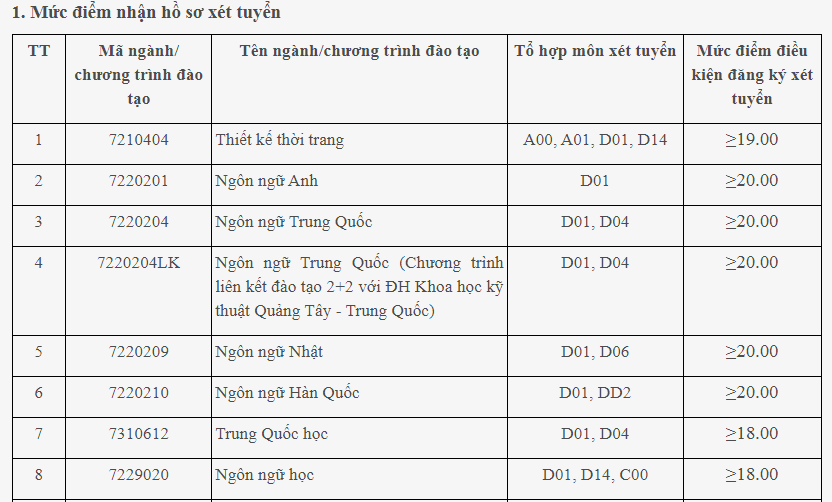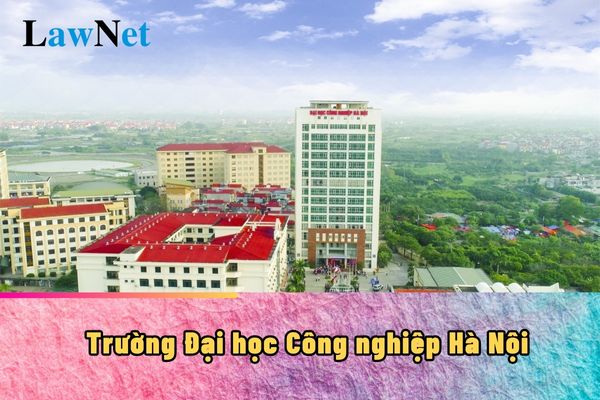Vietnam: What are the minimum admission scores of Hanoi University of Industry 2024?
What are the minimum admission scores of Hanoi University of Industry 2024?
These are the official minimum admission scores for full-time undergraduate programs for 2024 according to Method 3 - Admission by the High School Graduation Exam results in 2024.
Score calculation method and admission principles: According to the enrollment scheme for 2024 of Hanoi University of Industry issued together with Decision 342/QD-DHCN dated March 21, 2024 Download, the minimum admission scores of Hanoi University of Industry 2024 are as follows:





The minimum admission score for Hanoi University of Industry 2024 according to Method 3 - Admission by the High School Graduation Exam results in 2024 is at least 18 points.

What are the minimum admission scores of Hanoi University of Industry 2024? (Image from Internet)
Is equality among educational institutions required in enrollment for full-time undergraduate programs in Vietnam?
Under the regulation at Article 4 of the Regulation on Enrollment for full-time Undergraduate and College programs in Early Childhood Education issued together with Circular 08/2022/TT-BGDDT, the regulations are as follows:
Basic principles in enrollment
1. Fairness towards candidates
a) Information provision: Each interested candidate must be provided with complete, clear, reliable, consistent, and prompt information to make appropriate decisions and best prepare for enrollment;
b) Opportunity to apply: No candidate should lose their opportunity to apply due to unrelated regulations (except specific regulations by the Ministry of Public Security and the Ministry of National Defense in defense and security fields) or because of cumbersome, costly procedures;
c) Capability assessment: Candidates must be objectively, fairly, and reliably assessed on their academic abilities and potential success to meet the requirements of the program and field of study;
d) Admission opportunity: Candidates should have the highest opportunity to be admitted and the right to determine preferred fields and programs they qualify for;
dd) Fulfillment of commitments: educational institutions must fulfill their commitments to candidates; provide advice, support, and address complaints to protect candidates' legitimate rights in cases of risk.
2. Equality among educational institutions
a) Cooperation: educational institutions should cooperate on equal terms to improve the quality and efficiency of enrollment, bringing the best benefits to candidates;
b) Competition: educational institutions should engage in honest, fair, and healthy competition in enrollment according to the law on competition.
3. Transparency to Society
a) Regarding information transparency: Educational institutions are responsible for publicly announcing full, clear, and prompt admission information through suitable media for public and regulatory oversight;
b) Regarding accountability: Educational institutions are obliged to report upon request by regulatory agencies and explain issues of great concern to the public in a suitable manner.
One of the principles in enrollment for full-time undergraduate programs in Vietnam is equality among educational institutions. To be specific:
- Cooperation: educational institutions should cooperate on equal terms to improve the quality and efficiency of enrollment, bringing the best benefits to candidates;
- Competition: educational institutions should engage in honest, fair, and healthy competition in enrollment according to the law on competition.
Thus, according to the above regulations, Hanoi University of Industry must ensure equality among training institutions upon enrollment for full-time undergraduate programs in 2024.
What are the regulations on autonomously organizing enrollment by universities in Vietnam?
Under Article 20 of the Regulation on Enrollment for full-time Undergraduate and College programs in Early Childhood Education issued together with Circular 08/2022/TT-BGDDT:
Admission and processing of aspirations according to the General Plan
1. educational institutions autonomously organize enrollment according to their methods and criteria or voluntarily coordinate as a group to organize enrollment according to shared methods and criteria. The Ministry of Education and Training guides the admission schedule and supports the processing of aspirations on the system.
2. After completing the aspiration registration period on the system, educational institutions download information and data from the system to serve enrollment, including aspiration registration data, high school graduation exam results, and high school academic results of candidates applying to the educational institutions through various enrollment methods.
3. Admission Principles
a) Matriculation scores are determined to match the number of students admitted to each training program, suitable with the announced targets, but not lower than the minimium admission score;
b) For a training program (or a training program) by a method and subject combination, all candidates are considered equally by their scores, regardless of the priority order of the registered aspirations, except as stipulated in point c of this clause;
c) In case many candidates have the same score at the end of the list, the educational institution may use an additional criterion of aspiration order (to select candidates with a higher aspiration order);
d) The use of area and subject priority points for admission ensures uniformity with the priority point provisions stipulated in Article 7 of this Regulation.
4. After each admission cycle, the educational institution uploads to the system the list of candidates expected to be conditionally admitted to training programs (according to enrollment methods). The aspiration processing system automatically removes lower aspirations from the lists of candidates who conditionally meet multiple aspirations, returning the list of candidates conditionally admitted based on the highest aspiration.
5. Based on the aspiration processing results, the educational institution repeats the admission process in the next cycle, adjusting matriculation scores to match the targets within the specified timeframe. In the final cycle, the educational institution decides the matriculation scores for training programs (according to enrollment methods) and uploads the (official) list of candidates conditionally admitted to the system.
Based on the final aspiration processing results, the educational institution decides the list of candidates admitted to training programs.
6. Educational institutions announce the matriculation scores (and any additional conditions or criteria) for training programs according to enrollment methods; organize for candidates to check their admission results on the educational institution's website (or the coordinated group's website).
Universities will autonomously organize enrollment according to their methods and criteria or voluntarily coordinate as a group to organize enrollment according to shared methods and criteria.
The Ministry of Education and Training guides the admission schedule and supports the processing of aspirations on the system.

